It’s been a big year for Detroit’s Big Three automakers, and while the overall upturn of the U.S. market has helped them score gains in everything from hybrid to compacts to midsize sedans, nothing has buoyed their market share and bottom line more than the revival of pickup truck demand.
No surprise, Toyota is eying that market with envious ambition. The Japanese maker has long dominated the compact truck market with its Tacoma model, but despite repeated attempts, Toyota has failed to crack the code on the bigger – and traditionally more domestic-loyal full-size pickup segment.
It seemed to have a winner in hand when the Toyota Tundra went through a major redesign six years ago, but after an initial burst of growth sales collapsed. To be fair, the entire full-size truck market collapsed, declining by roughly half during the depths of the Great Recession, but Toyota is now lagging the pickup rebound and is anxious to regain momentum with the Tundra redesign it’s bringing to market for the 2014 model-year.
On the plus side, the new truck will get a more macho appearing, a markedly improved interior, some functional improvements and changes to the model mix designed to better target specific niches within the full-size pickup market. And one has to assume it will maintain the traditional Toyota Tundra reputation for quality, reliability and dependability, or QRD, a big selling point in the work truck market.
On the other hand, the new 2014 Toyota Tundra will still lag behind key competitors in the range of available powertrain options – notably with no alternatives to the high-mileage Ford EcoBoost V-6 and new Ram 1500 diesel engines. And it surprisingly misses out on some of the neat and useful touches those competitors have, whether an easy step-up for loading cargo or storage bins tucked into the cargo bed walls.
(First drive: 2014 Chevrolet Silverado. Click Herefor the review.)
Nonetheless, Toyota planners have fairly big ambitions on the boards. They hope to begin rebuilding Tundra demand once the first of the new trucks reaches showrooms next month and for 2014, they’re aiming to boost demand by almost 30%, to 137,000.
Can they pull it off, never mind eventually get near the roughly 200,000 Tundras Toyota sold before the recession? To get a sense, TheDetroitBureau.com headed to the Laurel Highlands, a scenic mountain region 90 minutes south of Pittsburgh, to put the 2014 model through its paces.
The updated Tundra generated a fair bit of controversy when it made its auto show debut in Chicago earlier this year, critics lamenting it hadn’t undergone enough of a change. To some extent, as noted above, they’re right. And the lack of more variants, including a long wished-for heavy duty model, was clearly a disappointment.
(Ram 1500 nabs top full-size rating from Consumer Reports. Click Here for the full story.)
That said, one has to realize that the full-size pickup segment is not just one of the market’s most loyal but also among the most conservative. While we’ve seen a few revolutionary designs transform the market – as Chrysler did, a few generations back, with the Ram – buyers often look for subtle, and usually more functional changes. Certainly, General Motors is making that argument with the new-for-2014 remakes of its Chevrolet Silverado and GMC Sierra trucks.
Toyota’s goal was, if anything, to make the 2014 Tundra a bit more traditional, “to make its looks match its capabilities,” explained chief engineer and part-time farmer Mike Sweers. From an exterior standpoint that meant a 40 millimeter increase in the hood height, for example, and design tweaks to emphasize the width of the tailgate – which now has the TUNDRA name deeply embossed in the sheet metal.
Other changes are not readily obvious, like the so-called “vortex generators” that improve aerodynamics and, in particular, improve straight-line stability, Toyota claims.
Where potential buyers will notice a more dramatic change is in the 2014 Toyota Tundra’s cabin. Gone are the days when even the most stripped-down truck can look like a piece of function-over-form machinery. The outgoing Tundra featured a bland and uninspired interior that – like a lot of other Toyota products of late – relied on far too much low-end plastic.
The new model is a definite step up in terms of both the quality of its materials and the way they’re colored and grained. The layout of the instruments is better, the gauges and controls somewhat relocated to make them easier to read or reach. There’s now a small TFT screen in the center cluster and all 2014 Tundras will boast rearview cameras, a distinct plus. The seats, meanwhile, feature not only improved comfort but on optional versions an upgraded ventilation system to keep you cool and dry after a day’s work on a hot job site.
(Ford offers hints of what’s coming with next F-150. Click Hereto find out more.)
Along with the new rearview camera, the 2014 Toyota Tundra will be offered with such new safety features as Blind Spot Detection, Cross Traffic Alert and Trailer Sway Control. It also gets an updated version of the maker’s Entune infotainment system with new features on top of the existing smartphone app links, including Yelp, Facebook Places, Pandora, Open Table and more.
That said, the cabin is still a bit generic, not quite as sophisticated and well-executed as even the now-aging Ford F-Series or the new Dodge Ram. But it’s a big improvement and one that should generate a lot of enthusiasm, especially from Toyota loyalists.
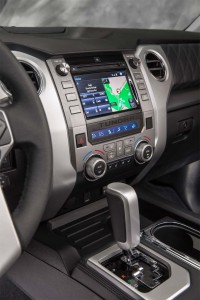
The center stack of this Tundra Platinum edition features Toyota's latest update of the Entune infotainment system.
Comfort aside, trucks are meant to do some serious work and Toyota has a trio of powertrains available for the 2014 Tundra:
- A base 4.0-liter 24-valve V-6 making 270 horsepower and 278 pound-feet of torque;
- A 4.6-liter 32-valve V-8 bumping that to 310 hp and 327 lb-ft; and the big bruiser,
- A 5.7-liter 32-valve V-8 punching out 381 hp and 401 lb-ft.
The 5.7-liter package can handle a hefty 2,000-pound payload and 9,200 pounds of trailer. It’s by no means the highest-rated pickup, but Toyota is quick to question the competition’s claims, noting it is the only full-size truck maker to adopt the SAE’s stringent J2807 towing standard, despite promises by the rest of the field to go along. Expect to see it make a lot with the tagline, “Truth in Towing.”
Nonetheless, Toyota itself gets flak for not coming up with more sophisticated engine packages, such as Ford’s V-6 EcoBoost or the new Ram diesel. Does it matter? Chief Engineer Sweers asserts that under real-world, heavy-load conditions, the biggest of the Tundra engines delivers “almost 20%” better mileage than the EcoBoost. That said, don’t expect to see hard EPA fuel economy numbers for the 2014 Tundra line until closer to its sales launch next month.
While we didn’t get the chance to tow we did take the 2014 Tundra equipped with the 5.7-liter V-8 out on several drive courses, including both on-road and off. Despite the long wheelbase, the truck proved surprisingly nimble on a fairly aggressive course that included water fording, log crawls and a variety of other obstacles that few leveled challenges few owners and operators will ever experience.
On pavement, the truck is stable, quiet and reasonably comfortable – except in tight corners where we were surprised by the amount of body roll and tire noise. It wasn’t enough to worry us but we expected a bit more nimbleness on the road.
(New face, more power for 2014 GMC Sierra Denali. Click Here for more.)
For many pickup buyers, however, the real obstacle to purchase could be the name. Full-size truck buyers are among the first to wave the flag – and to follow it to the nearest Detroit showroom. Toyota hopes to overcome that problem by promoting the fact that the 2014 Tundra was designed and engineered in the U.S. and then assembled in a dedicated plant in San Antonio, Texas. It even has more North American content than some domestic competitors, the maker points out.
Will that win buyers over? In terms of pricing we’ll also have to wait until closer to launch. But the bottom line is a truck that’s quite good though by no means the industry benchmark, especially when considering some of the shortfalls, such as the lack of a cargo bed step-up and even more sophisticated powertrain options – never mind a heavy-duty package. If you don’t need such niceties, the 2014 Toyota Tundra is worth considering if you’re open to an “import” nameplate.

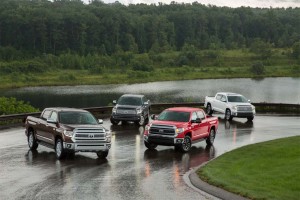
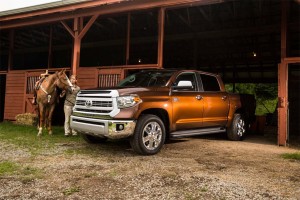

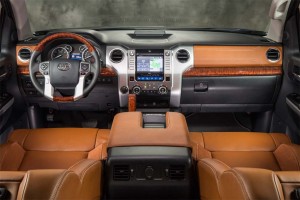
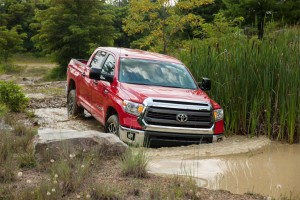
The front end styling is an effort to look more like a Ford with the high squared grille/hood. The Asians are very good at copying styling cues from Mercedes, BMW and Audi so they should be able to do the same with Ford, GM and Dodge RAM trucks.